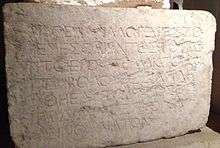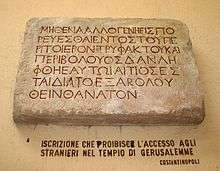Temple Warning inscription
| Temple Warning Inscription | |
|---|---|
 The inscription in its current location | |
| Material | Limestone |
| Writing | Greek |
| Created | c. 23 BCE – 70 CE[1] |
| Discovered | 1871 |
| Present location | Istanbul Archaeology Museums |
| Identification | 2196 T |
The Temple Warning inscription, also known as the Temple Balustrade inscription or the Soreg inscription[2], is an inscription that hung along the balustrade outside the Sanctuary of the Second Temple in Jerusalem. Two of these tablets have been found.[3] A complete tablet was discovered in 1871 by Charles Simon Clermont-Ganneau and published by the Palestine Exploration Fund.[1] Following the discovery of the inscription, it was taken by the Ottoman authorities, and it is currently in the Istanbul Archaeology Museums. A partial fragment of the inscription was found in 1936 by J. H. Iliffe in Jerusalem's Lions' Gate, and is held in the Israel Museum.[1][4]
Inscription
The inscription was a warning to pagan visitors to the temple not to proceed further. Both Greek and Latin inscriptions on the temple's balustrade served as warnings to pagan visitors not to proceed under penalty of death.[3][5] Two authentic tablets have been found, one complete, and the other a partial fragment with missing sections, but with letters showing signs of the red paint that had originally highlighted the text.[5] It was described by the Palestine Exploration Fund in 1872 as being "very nearly in the words of Josephus".[6][7][8]
The inscription uses three terms referring to temple architecture:[9]
Translation
The tablet bears the following inscription in Koine Greek:
| Original Greek | In minuscles with diacritics | Transliteration[10] | Translation[11] |
|---|---|---|---|
| ΜΗΘΕΝΑΑΛΛΟΓΕΝΗΕΙΣΠΟ
ΡΕΥΕΣΘΑΙΕΝΤΟΣΤΟΥΠΕ ΡΙΤΟΙΕΡΟΝΤΡΥΦΑΚΤΟΥΚΑΙ ΠΕΡΙΒΟΛΟΥΟΣΔΑΝΛΗ ΦΘΗΕΑΥΤΩΙΑΙΤΙΟΣΕΣ ΤΑΙΔΙΑΤΟΕΞΑΚΟΛΟΥ ΘΕΙΝΘΑΝΑΤΟΝ |
Μηθένα ἀλλογενῆ εἰσπο-
ρεύεσθαι ἐντὸς τοῦ πε- ρὶ τὸ ἱερὸν τρυφάκτου καὶ περιβόλου. Ὃς δ᾽ ἂν λη- φθῇ, ἑαυτῶι αἴτιος ἔσ- ται διὰ τὸ ἐξακολου- θεῖν θάνατον. |
Mēthéna allogenē eispo[-]
reúesthai entòs tou pe[-] rì tò hieròn trypháktou kaì peribólou. Hòs d'àn lē[-] phthē heautōi aítios és[-] tai dià tò exakolou[-] thein thánaton. |
No stranger is to enter
within the balustrade round the temple and enclosure. Whoever is caught will be himself responsible for his ensuing death. |
Forgeries

Several forgeries were promptly prepared following the 1871 discovery.[12] Clermont-Ganneau was shown a similar artifact at the Monastery of St Saviour, which was later shown to be a forgery created by Martin Boulos.[13]
References
- 1 2 3 Corpus Inscriptionum Iudaeae/Palaestinae, Jerusalem, Part 1, Walter de Gruyter, 2010, ISBN 9783110222203], page 42
- ↑ Magness, Jodi (2012). The Archaeology of the Holy Land: From the Destruction of Solomon's Temple to the Muslim Conquest. Cambridge University Press. p. 155.
- 1 2 Bickerman, Elias J. “The Warning Inscriptions of Herod's Temple.” The Jewish Quarterly Review, vol. 37, no. 4, 1947, pp. 387–405.
- ↑ Israel Museum, ID number: IAA 1936-989
- 1 2 Llewelyn, Stephen R., and Dionysia Van Beek. “Reading the Temple Warning as a Greek Visitor.” Journal for the Study of Judaism in the Persian, Hellenistic, and Roman Period, vol. 42, no. 1, 2011, pp. 1–22.
- ↑ Palestine Exploration Fund (1872). Quarterly Statement - Palestine Exploration Fund. Published at the Fund's Office. pp. 121–.
- ↑ "Josephus: Of the War, Book V". penelope.uchicago.edu. Retrieved 2018-03-03.
Upon it stood pillars, at equal distances from one another; declaring the law of purity, some in Greek and some in Roman letters; that no foreigner should go within that sanctuary. For that second [court of the] temple was called the sanctuary: and was ascended to by fourteen steps from the first court.
- ↑ DE LATINISMEN IN HET GRIEKS VAN HET NIEUWE TESTAMENT, p.15: διὰ τούτου προϊόντων ἐπὶ τὸ δεύτερον ἱερὸν δρύφακτος περιβέβλητο λίθινος, τρίπηχυς μὲν ὕψος, πάνυ δὲ χαριέντως διειργασμένος: ἐν αὐτῷ δὲ εἱστήκεσαν ἐξ ἴσου διαστήματος στῆλαι τὸν τῆς ἁγνείας προσημαίνουσαι νόμον αἱ μὲν Ἑλληνικοῖς αἱ δὲ Ῥωμαϊκοῖς γράμμασιν μηδένα ἀλλόφυλον ἐντὸς τοῦ ἁγίου παριέναι (BJ 5.2.2, §193-194) [transliterated: diá toútou proïónton epí tó défteron ierón drýfaktos perivévlito líthinos, trípichys mén ýpsos, pány dé chariéntos dieirgasménos: en aftó dé eistíkesan ex ísou diastímatos stílai tón tís agneías prosimaínousai nómon ai mén Ellinikoís ai dé Romaïkoís grámmasin midéna allófylon entós toú agíou pariénai]; Also at Perseus
- ↑ Bickerman, 1947, pages 387–389: "To begin with, there are three terms referring to the architectural complex of the Temple. Το ίερόν, "holy place," is the designation of the consecrated area, to which the fore-court led. This area was called by the Jews "sacred," mikdosh (הַמִּקְדָּשׁ). The word ίερόν was common in this sense in Greek and applied to pagan cults. For this reason it was avoided by the Alexandrian translators of the Scripture who use the term το άγιον in referring to the Temple of Jerusalem. But after the Maccabean victory, the Jews had less scruples about using a technical term from Greek heathenism. On the other hand, the word το άγιον which had become fashionable for Oriental holy places, was no longer a distinctive term in Herod's time. Accordingly, Philo and Josephus use both words, ίερόν and άγιον to designate the Temple of Herod. The περίβολος was the wall which encompassed the holy terrace within the outer court. Josephus, Philo and the Septuagint use this Greek word, technical in this connotation, to describe the enclosure of the Temple. The τρύψακτος, the Soreg in the Mishna, was a stone barrier which stretched across the outer court to protect the flights of stairs leading up to the inner court. As we said, the warning inscriptions were fixed on this rail."
- ↑ Note: The original text is written in scriptio continua; the "[-]" symbol in the transliteration represents the Greek words which are broken across two lines
- ↑ Discovery of a Tablet from Herod's Temple
- ↑ Cadbury, Henry J. (1 October 2004). The Book of Acts in History. Wipf and Stock Publishers. pp. 96–. ISBN 978-1-59244-915-6.
It was so satisfactory that skilful natives promptly forged several duplicates
- ↑ "Quarterly statement | Palestine Exploration Fund, 1884". archive.org. Retrieved 2015-11-15.
External references
- Clermont-Ganneau, Charles Simon (30 May 1871). "Discovery of a Tablet from Herod's Temple" (PDF). Palestine Exploration Quarterly. 3 (3): 132–134. doi:10.1179/peq.1871.013. Retrieved 2018-02-27.
Google books reference at
- Dr. Carl Rasmussen. "Holy Land Photos". holylandphotos.org. Retrieved 2015-11-15.
- Cotton, H. (2010). CIIP. De Gruyter. p. 42. ISBN 9783110222197. Retrieved 2015-11-15.
- Millard, Alan, Discoveries from the Time of Jesus. Oxford: Lion Publishing, 1990.
- Roitman, Aldopho, Envisioning the Temple, Jerusalem: The Israel Museum, 2003.
- Elias J. Bickerman, "The Warning Inscriptions of Herod's Temple," The Jewish Quarterly Review, New Ser., Vol. 37, No. 4. (Apr., 1947), pp. 387–405.